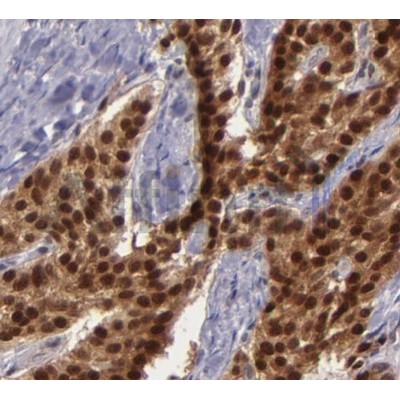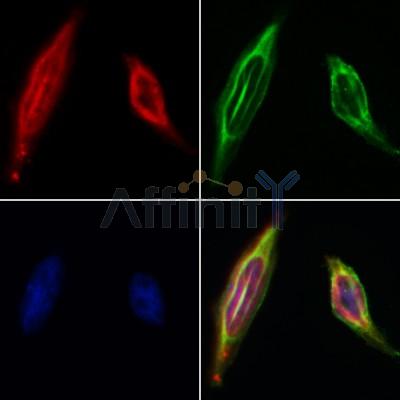Bag 1 Antibody - #AF5136
| Product: | Bag 1 Antibody |
| Catalog: | AF5136 |
| Description: | Rabbit polyclonal antibody to Bag 1 |
| Application: | WB IHC IF/ICC |
| Reactivity: | Human, Mouse, Rat |
| Mol.Wt.: | 31 kDa; 39kD(Calculated). |
| Uniprot: | Q99933 |
| RRID: | AB_2837622 |
Related Downloads
Protocols
Product Info
*The optimal dilutions should be determined by the end user.
*Tips:
WB: For western blot detection of denatured protein samples. IHC: For immunohistochemical detection of paraffin sections (IHC-p) or frozen sections (IHC-f) of tissue samples. IF/ICC: For immunofluorescence detection of cell samples. ELISA(peptide): For ELISA detection of antigenic peptide.
Cite Format: Affinity Biosciences Cat# AF5136, RRID:AB_2837622.
Fold/Unfold
Bag 1; BAG family molecular chaperone regulator 1; BAG-1; BAG1; BAG1_HUMAN; BCL 2 Associated Athanogene 1; BCL 2 associated athanogene; BCL 2 binding athanogene 1; Bcl-2-associated athanogene 1; BCL2 associated athanogene 1; BCL2 associated athanogene; Glucocorticoid receptor-associated protein RAP46; HAP1; Haptoglobin; RAP 46; RAP46;
Immunogens
A synthesized peptide derived from human Bag 1, corresponding to a region within N-terminal amino acids.
Isoform 4 is the most abundantly expressed isoform. It is ubiquitously expressed throughout most tissues, except the liver, colon, breast and uterine myometrium. Isoform 1 is expressed in the ovary and testis. Isoform 4 is expressed in several types of tumor cell lines, and at consistently high levels in leukemia and lymphoma cell lines. Isoform 1 is expressed in the prostate, breast and leukemia cell lines. Isoform 3 is the least abundant isoform in tumor cell lines (at protein level).
- Q99933 BAG1_HUMAN:
- Protein BLAST With
- NCBI/
- ExPASy/
- Uniprot
MAQRGGARRPRGDRERLGSRLRALRPGREPRQSEPPAQRGPPPSGRPPARSTASGHDRPTRGAAAGARRPRMKKKTRRRSTRSEELTRSEELTLSEEATWSEEATQSEEATQGEEMNRSQEVTRDEESTRSEEVTREEMAAAGLTVTVTHSNEKHDLHVTSQQGSSEPVVQDLAQVVEEVIGVPQSFQKLIFKGKSLKEMETPLSALGIQDGCRVMLIGKKNSPQEEVELKKLKHLEKSVEKIADQLEELNKELTGIQQGFLPKDLQAEALCKLDRRVKATIEQFMKILEEIDTLILPENFKDSRLKRKGLVKKVQAFLAECDTVEQNICQETERLQSTNFALAE
Research Backgrounds
Co-chaperone for HSP70 and HSC70 chaperone proteins. Acts as a nucleotide-exchange factor (NEF) promoting the release of ADP from the HSP70 and HSC70 proteins thereby triggering client/substrate protein release. Nucleotide release is mediated via its binding to the nucleotide-binding domain (NBD) of HSPA8/HSC70 where as the substrate release is mediated via its binding to the substrate-binding domain (SBD) of HSPA8/HSC70. Inhibits the pro-apoptotic function of PPP1R15A, and has anti-apoptotic activity. Markedly increases the anti-cell death function of BCL2 induced by various stimuli.
Ubiquitinated; mediated by SIAH1 or SIAH2 and leading to its subsequent proteasomal degradation.
Nucleus. Cytoplasm.
Note: Isoform 1 localizes predominantly to the nucleus.
Cytoplasm. Nucleus.
Note: Isoform 2 localizes to the cytoplasm and shuttles into the nucleus in response to heat shock.
Cytoplasm. Nucleus.
Note: Isoform 4 localizes predominantly to the cytoplasm. The cellular background in which it is expressed can influence whether it resides primarily in the cytoplasm or is also found in the nucleus. In the presence of BCL2, localizes to intracellular membranes (what appears to be the nuclear envelope and perinuclear membranes) as well as punctate cytosolic structures suggestive of mitochondria.
Isoform 4 is the most abundantly expressed isoform. It is ubiquitously expressed throughout most tissues, except the liver, colon, breast and uterine myometrium. Isoform 1 is expressed in the ovary and testis. Isoform 4 is expressed in several types of tumor cell lines, and at consistently high levels in leukemia and lymphoma cell lines. Isoform 1 is expressed in the prostate, breast and leukemia cell lines. Isoform 3 is the least abundant isoform in tumor cell lines (at protein level).
Research Fields
· Genetic Information Processing > Folding, sorting and degradation > Protein processing in endoplasmic reticulum. (View pathway)
Restrictive clause
Affinity Biosciences tests all products strictly. Citations are provided as a resource for additional applications that have not been validated by Affinity Biosciences. Please choose the appropriate format for each application and consult Materials and Methods sections for additional details about the use of any product in these publications.
For Research Use Only.
Not for use in diagnostic or therapeutic procedures. Not for resale. Not for distribution without written consent. Affinity Biosciences will not be held responsible for patent infringement or other violations that may occur with the use of our products. Affinity Biosciences, Affinity Biosciences Logo and all other trademarks are the property of Affinity Biosciences LTD.







